Capicola is a type of Italian meat that is covered in spices and dry-cured. It is renowned for its strong, spicy flavor, typical for many kinds of charcuterie originating from Europe. But what we love about this meat is its succulent texture. Ribbons of fat provide a lovely buttery mouthfeel that balances the spices perfectly. Unlike prosciutto, which some find chewy, capicola is much easier to eat. Ideal on an antipasto platter, in subs, or topped on a pizza.
Depending on where you live, finding the correct cut of meat can be a challenge. It is essential to use the right meat, though, with 70% lean meat and 30% fat. To get this ratio, a butcher will cut it from the pork butt and shoulder. In Italy, it is called the coppa muscle – located between the head and the fifth rib of the shoulder.
Recommended equipment
Making homemade capicola involves dry curing a cut of meat that’s smothered in flavor-packed spices. Although you don’t need any fancy equipment, you will need a basic vacuum sealer to get consistent results. The process is quite simple, and the biggest challenge is mustering up the patience to allow time for the pork to cure.
To make your job easier, using the Umai system is a good idea. It includes a spice kit, juniper berries, instacure, and curing bags. You can get the Umai Dry Curing set here [affilate link].
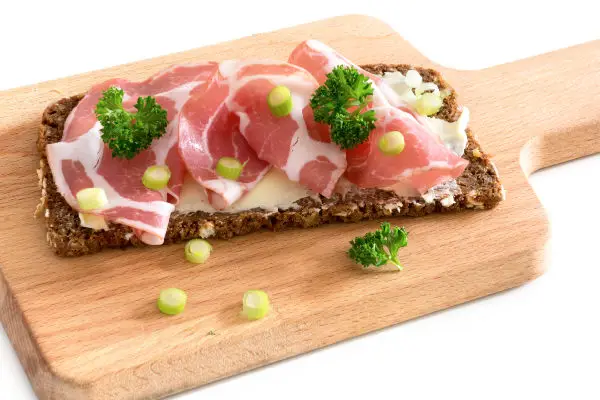
Important ratios
Each cut of meat varies in weight, so the best way to determine the curing ingredients is to pull out a calculator.
- Use a ratio of 3% Kosher salt to meat.
- Use a ratio of 0.25% Instacure #2 to meat.
Here’s an example calculation. If you have 5 pounds of pork, divide 5 pounds by 2.2 then multiply by 1000. This quick formula gives you the weight of your meat in grams. In this case, it’s 2272 grams. Now multiply this number by 3% to get the required Kosher salt (68 grams).
Alternatively, you can also source a 3 ½ pound slab of pork and follow my recipe
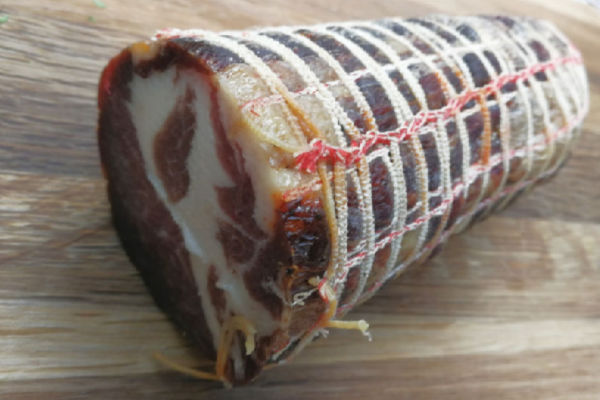
Homemade Capicola
Ingredients
- 30 gm sugar
- 48 gm kosher salt
- 4 gm instacure #2
- 3 gm Juniper berries
- 2 Tbsp ground black pepper
- 1 gm grated nutmeg
- 2 cloves garlic, minced
- 3 sprigs of fresh thyme
- 2 bay leaves
- 1 tablespoon chipotle powder
- 1/4 cup paprika
- 1/4 cup chili powder
Method
- Add sugar, kosher salt, and instacure, juniper berries, pepper, nutmeg, garlic, thyme, and bay leaves to a processor and blend until combined.
- Rub the spices all over the Copa muscle until the entire surface has a thin coating. Then place in a ziplock bag or, to ensure no air gets in, use a vacuum sealer.
- Place the meat in the refrigerator for 7-14 days, turning every other day.
- Remove the meat from the bag and lightly rinse off the bulk of the seasoning. It is okay for some seasoning to remain.
- Combine chipotle, paprika, and chili in a bowl. Rub the meat with spice mix liberally then allow to sit on the bench to rest.
- Cover the pork in meat netting then place it in an Umai bag and vacuum seal. Place in the refrigerator, on a cooling rack to allow air circulation for 6-10 weeks or until the meat reduces by 35-40%. Remember to turn the meat in the fridge occasionally.
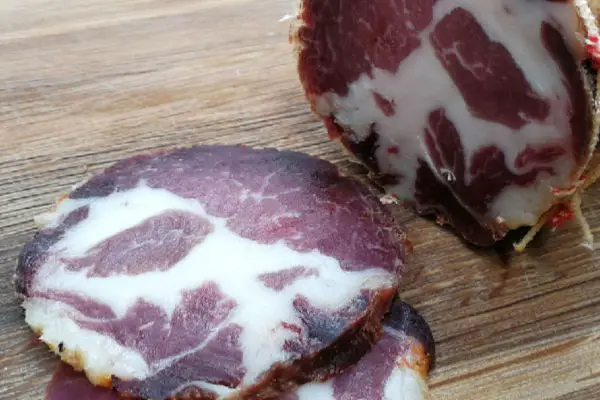
Tips to help your capicola making
Use digital scales
Always weigh the salt in grams, not using teaspoons or tablespoons. Different types and brands of salt vary in weight, so be sure to use accurate digital scales.
Meat netting is not essential
Meat netting can be substituted for butcher’s twine. It takes a little more skill but it’s something you can improve on over the years. If it all sounds like too much work then you can buy a massive 50 feet of size 16 meat netting roll online from Amazon [affiliate link].
Don’t open the meat from its bag too early
You know the capicola is done when the original cut has reduced by a 35-40% reduction in weight.
Adjusting the spices is okay
Reduce the black pepper and chili if you don’t want too much of a spicy hit. But don’t adjust the kosher salt or instacure ratios.
Equalize the meat
After the meat has been cured, open the umai bag and remove it. Place the capicola in a regular vacuum bag and seal. Refrigerate for two weeks to equalize the meat. This can enhance the flavor and help to harden the case.
Instructions for adding meat netting to capicola
Depending on the meat netting used, people often have trouble stretching it over a slab of pork. To make your life easier, follow these steps:
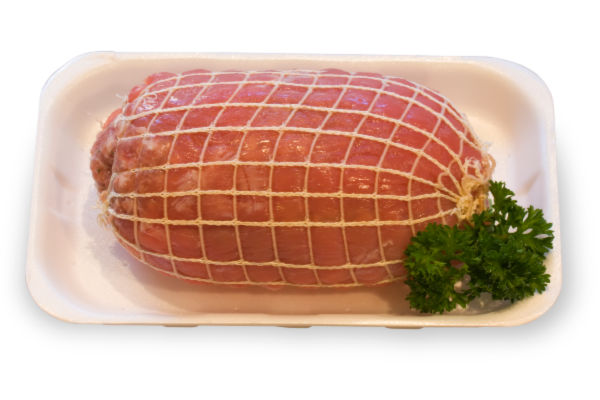
- Slice the bottom off a large plastic soft drink bottle. Slowly ease the netting onto the outside of the bottle (over the neck) until it covers half the vessel.
- Place the pork inside the bottle and pull the netting completely over the bottle. Tie off the netting so that the meat can’t fall out.
- Cut the end off the netting on the other side, allowing 6 inches of extra mesh at the top.
- Slide the netting from the top down to the bottom of the bottle then pull out the meat from the bottle. It should pop out, covered tightly in the net.
- Tie off the end of the netting.
Traditional curing technique
We have used the fridge for curing the meat as it provides a consistent temperature. However, if you have an underground basement or a drying room, then these are both excellent alternatives.
During the drying process, it is ideal that the temperature stays around 60F (15.5C), and humidity stays around 70%. Humidity below 60% can cause the outer casing of the sausage to dry too fast and prevent the inside from drying. To find out more, check out our resource on how to dry sausage at home.
Can you eat Coppa raw?
Coppa is dry-cured and is best eaten raw. Although it can be cooked, it’s one of those meats where the fat melts, and the pinky-red protein turns brown.
Final words
If you haven’t yet tried capicola or capocollo, then you are missing out. This dry-cured meat is delicious served raw on a platter or in a sandwich. The flavor is spicy and intense with marbles of fat that provide a perfectly balanced salami. Although Southern Italy has made this meat since the early 1900s, the meat has gained interest since Tony Soprano referred to it as gabagool in the series The Sopranos.
Why would you want to make this at home? To begin with, it’s a challenge to find in many parts of the United States unless you’re near an Italian neighborhood. But why buy it from a shop? It is simple to make at home and no special grinders or sausage making equipment is needed.
Have you tasted capicola before? Let us know in the comments below.

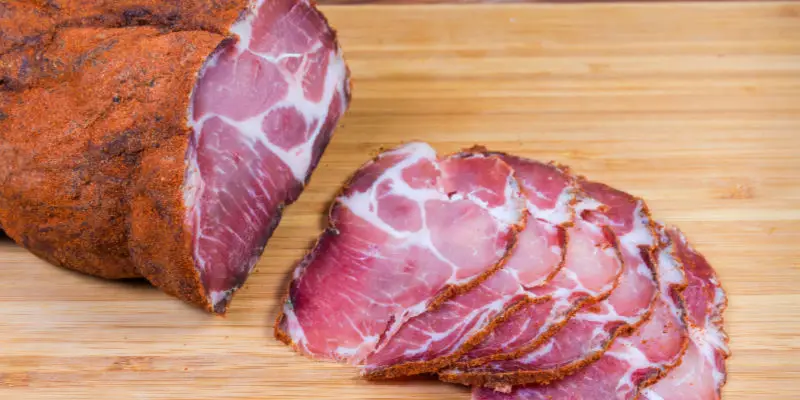

Good day
I love learning about making and curing meat.
I am finding it difficult to believe that 100-200yrs ago the mammas in Italy were using scales and thermometers to cure their meat.
Is there any way to get recipes from the Mamas of Italy who still live in the country side and use fire stoves and ask them how they make their meats.
I true testament to how it should be done.